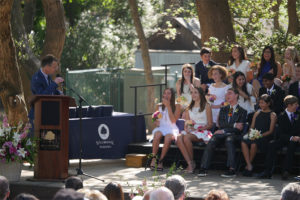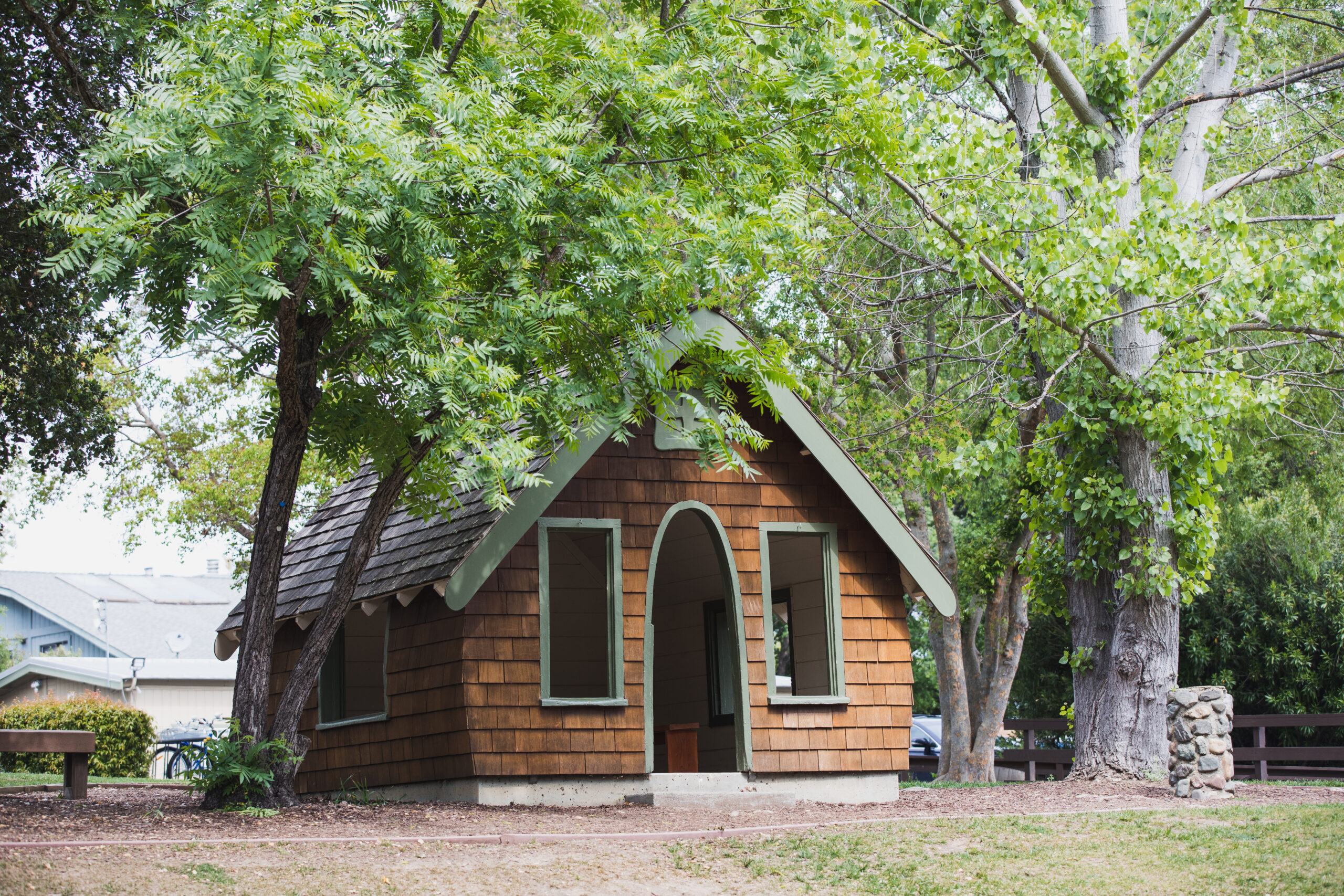 Good morning and welcome to the 2017 Hillbrook school graduation ceremony. I want to extend a special welcome this morning to our guests on stage with me, including Los Gatos Mayor Marico Sayoc, Chair of the Board of Trustees Chuck Hammers, Head of Middle School Christina Pak, 8th grade level coordinator Eden Maisel, and Chris Hailey, graduate from the Class of 2013. Most importantly, it is my honor to welcome the soon to be graduated members of the Class of 2017.
Good morning and welcome to the 2017 Hillbrook school graduation ceremony. I want to extend a special welcome this morning to our guests on stage with me, including Los Gatos Mayor Marico Sayoc, Chair of the Board of Trustees Chuck Hammers, Head of Middle School Christina Pak, 8th grade level coordinator Eden Maisel, and Chris Hailey, graduate from the Class of 2013. Most importantly, it is my honor to welcome the soon to be graduated members of the Class of 2017.
A graduation is both an ending and a beginning. For the forty 8th graders behind me today, it represents the end of their time as students on our campus, the culmination of elementary and middle school, 10 years of extraordinary learning and growth. Through it all they were nurtured, challenged, and inspired by teachers who know them and care for them as people and learners. Teachers who continually push them to live out Hillbrook’s core values – be kind, be curious, take risks, be your best. I know that all of those teachers share with me incredible pride in their accomplishments to date, as well as extraordinary optimism for what they will do in the future.
Of course the graduates of the Class of 2017 are not the only ones undergoing a change. In front of me sit their proud parents and in many cases proud grandparents, uncles, aunts, and siblings. For the parents, today also marks a major milestone. In particular, this year, we have a significant cohort of families who have spent more than a decade of their lives at Hillbrook, and whose youngest child or in some cases only child is graduating, meaning that the whole family will be transitioning to alum status in the year ahead. I trust that those families – and all of our graduates – will return often to share stories about how they are doing in the years ahead. While you may no longer be on our campus each day, you will always be a part of the Hillbrook family.
As I was trying to think of a good topic for today’s speech I found myself getting distracted. Every time I started to put a thought together, my mind was pulled in another direction. I felt like I was spinning out of control. What exactly was the problem? I was under the spell of fidget spinners. So instead of fighting it, I finally decided to give in and ask – what, if anything, can we learn from these ubiquitous little devices?
First, a little background for those of you in the audience, if there are any, who don’t yet know what I’m talking about. I remember the first time I saw a spinner. It was a Thursday in late April – or thereabouts – and I was walking through the Kindergarten area, past the bike track, by the swings, nearing the Kindergarten porch when I saw them – two Kindergartners spinning these little things, one on their finger, the other on their foot. “What’s that?” I asked innocently. By the end of the following week, I was seeing spinners everywhere – near the 1st/2nd grade picnic tables, on the 3rd/4th playground, in the Middle School science classrooms, even during Flag. Everyone was writing about them – the NY Times, the Wall Street Journal, the Atlantic Monthly. Even the Pope talked about them in a speech. I decided I had to get one for myself. And, since I didn’t want our 8th graders to feel left out, I decided that we should provide them with Hillbrook-engraved fidget spinners on their graduation. Hey, 8th graders, check under your seats.
So, now that we are all on the same page as to what a fidget spinner is, let’s get back to my question – what can we learn from the emergence of this toy?
Popularity can be difficult to explain. As numerous people have pointed out, fidget spinners have been around for years. Why did their popularity explode now? The best answer that I’ve heard argues that Youtube videos fed the craze, and yet no one can really point to a specific catalyst. One store owner described receiving a call in mid-April asking for one. He had never heard of it. 30 minutes later he received his second call. Today, he is receiving 20-30 calls per day. Others have pointed to previous toy trends – I am sure all of the 8th graders remember Silly Bandz when they were in 1st grade, Rainbow Loom in 2nd or 3rd grade, and Pokemon Go at the beginning of this school year. All of these things caught people’s attention and for a brief period of time seemed to be everywhere. They also seemed to disappear – or at a least fade – nearly as quickly as they appeared. Which takes me to my first point….
Don’t confuse popularity with meaning or significance. The fact that nearly everyone has a fidget spinner does not necessarily make the item important or meaningful. As previous toy trends have shown us, things appear and disappear quickly. While it may be difficult to buy a fidget spinner today, within a few weeks or months you’ll likely have no problem buying them. I encourage each of you to recognize the similarity between the fleeting popularity of a toy and the fleeting satisfaction of other things in your lives, like social media popularity. Receiving 100 likes on Instagram or Snapchat may feel good in the moment, but it is not – and should not be – seen as a measure of your value.
And, yet, while we will be well-served to remember that the fidget spinner is, ultimately, a toy, I also encourage you to recognize the positive lessons that a simple toy can provide. One of the mistakes that people sometimes make as they grow up is they forget how to play. While we are well aware of the importance of play for young children, many people don’t realize that play is critical for adults as well. Dr. Stuart Brown the head of the National Institute for Play – yes, that’s a real organization – points out the value. He describes play as “something done for its own sake.” He notes “it is voluntary, it’s pleasurable….and the act itself is more important than the outcome.” Think joining a soccer league, board games with friends and family, brain puzzlers on a Sunday afternoon. Play brings people together, keeps our minds active, and creates opportunities for us to laugh and be joyful. I think about the various moments in which I’ve seen groups of children playing with fidget spinners, and I see evidence of how a toy and play can bring people together.
Play is also an essential component of innovation and entrepreneurship. A playful mindset keeps us open to possibilities, encourages us to make new connections with people and ideas, and fuels our imagination. Silicon Valley is known for creating workplace cultures that incorporate play and silliness. Why? Because entrepreneurial leaders know that we need to retain a playful spirit in order to solve the world’s most complex problems. As playwright Nagle Jackson wrote, “The truly great advances of this generation will be made by those who can make outrageous connections, and only a mind which knows how to play can do that.” Put another way, I encourage each of you to take your work seriously, but never take yourself too seriously. Never be afraid to be silly, take risks, and even occasionally make yourself look like a fool. You never know – it may lead to the next great innovation that will take over Silicon Valley and the world.
So, Class of 2017, I guess the final lesson is don’t underestimate the power of something unexpected – even a toy – to teach you important lessons about life. Stay curious, keep taking risks, lead with kindness, and above all, be your best. Keep those Hillbrook fidget spinners as a reminder, and come back and visit often. We can’t wait to see what you will do to change the world.
